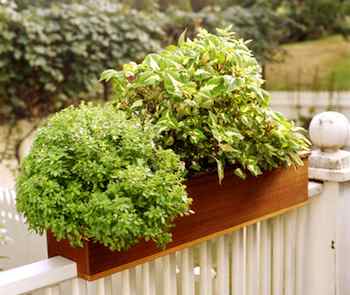By Sean Conway

A window box adapted to a railing is ideal for creating a small-space garden on a porch or deck
A daily walk through the garden to harvest a few vine-ripened tomatoes, some peppers or a handful of aromatic basil is a dream come true for anyone who enjoys cooking with fresh ingredients. Unfortunately, not everyone has the time or the space to cultivate a large vegetable garden. If you fall into that category, but still yearn to harvest fresh ingredients for a summertime meal, all you need to do is change your idea of what a garden should look like.
Gardening in small spaces is a trend that has taken hold with apartment dwellers, condo owners, and those who either don't have enough space for a large garden or the need for one. For many, a tomato plant or two, some basil and a few fresh herbs is all they need in a garden.
There are several options for small space gardens, and some don't even require ground to plant in. The simplest is 12-inch pot is large enough to grow three or four of your favorite herbs. Most herbs are sun lovers, so your pot will need at least five to six hours of direct sun. Anything less than four hours will lead to weak growth.
For those living in apartments or where balcony space is all that is available, a window box adapted to a railing will work just as well. Here at the Cultivating Life gardens we made ours out of rot resistant cedar. Be sure to use a well-drained potting soil mix with plenty of organic content to ensure abundant growth. As with most herbs, harvesting a few sprigs or leaves at a time is enough for most recipes.
If you own a deck, patio or terrace that offers a bit more space, vegetable boxes might be the perfect solution for a manageable garden. They are available at most DIY stores or garden centers and are often made from rot resistant cedar.
Vegetable boxes have the advantage of holding larger volumes of soil and thus can accommodate more plants than a pot or window box. But again, as with other containers, vegetable boxes must be positioned so they receive at least five to six hours of direct sun.
For best results, you'll need consider the growth habit of the vegetables you chose and position them in the box accordingly. Start with taller plants that may require staking like tomatoes in either the back or center of the box. Shorter plants such as basil, peppers or eggplant should go in front of the tomatoes, and trailing plants such as cucumbers, trailing squash or melons should go at the edge of the box, allowing them the opportunity to trail over the edge.
Taking advantage of a plant's growth habit also helps maximize space. Plants such as climbing pole beans or vining cherry tomatoes can be trained up a trellis attached to the back of the box.
Vegetable boxes are easy to maintain since they typically don't require a lot of weeding. Watering is a necessity, but placing your boxes near a water outlet makes that job much easier. An occasional feeding will ensure maximum productivity.
For those with a small yard or access to bare ground, square-foot gardening is a good option. In this method, a 3-foot by 3-foot square grid is laid out on the ground. Again, place taller plants in the center or the back and shorter plants and trailing plants in the front.
If the idea of harvesting fresh ingredients is an appealing one to you, don't let space constraints hold you back this season. Just change your idea of what a garden is, and think smaller for a change.
Available at Amazon.com:
Cut Your Energy Bills Now: 150 Smart Ways to Save Money & Make Your Home More Comfortable & Green
It's Easy Being Green: A Handbook for Earth-Friendly Living
Sean Conway's Cultivating Life: 125 Projects for Backyard Living
© SEAN CONWAY. DISTRIBUTED BY Tribune Media Services
AUTOS | HOBBIES | EDUCATION | FAMILY | FASHION | FOOD & RECIPES | HOME DECOR | RELATIONSHIPS | PARENTING | PETS | TRAVEL | WOMEN
Home & Garden - Small-Space Gardening: When the Back 40 Is on Your Porch Railing